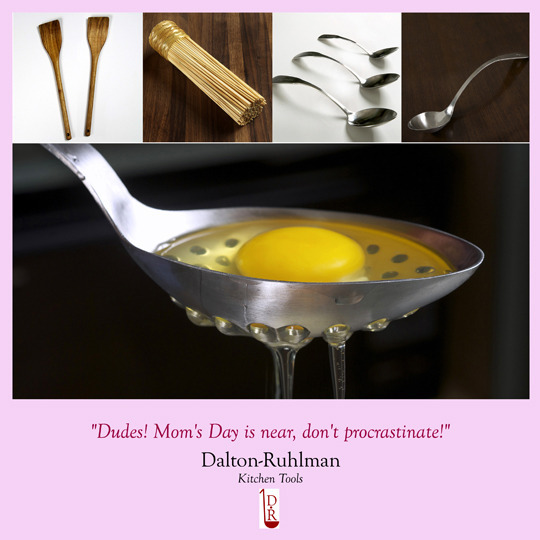Michael Ruhlman's Blog, page 42
April 24, 2013
On Schmaltz and Digital Publishing
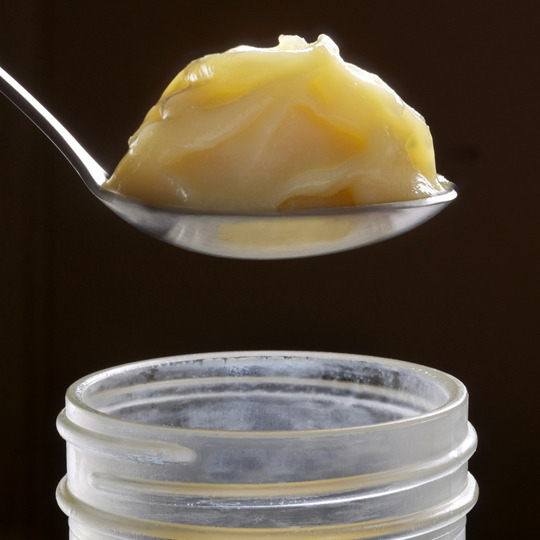
Schmaltz, chicken fat rendered with onion, an initial “cover” photo by Donna Turner Ruhlman.
By contractual agreement with Little, Brown, venerable publisher of so many of my favorite authors, I will be UNPUBLISHING The Book of Schmaltz: Love Song to a Forgotten Fat tomorrow morning, so that Little, Brown can roll out the book in hardcover this coming August. So, if you want it for your iPad or iPad mini at the lowest price you’ll ever see it, get it now (it’s received nothing but critical raves, I’m proud to say, and is being offered at half the price it will go for electronically in August and for one-quarter its hardcover jacket price). If you already own it, don’t delete it from your device and you will continue to be able to use it (see note at bottom of post for more info). It will be republished after the hardcover is out.
I’m happy to unpublish what Donna and I and others worked so hard on because I think it’s best suited to being a hardcover book (many, many have asked for this). Hardcover books are what mainstream publisher do well: print, warehouse, and ship books (a case of which has put my back out more than once). For those who prefer electronic books (I adore the search function in the digital cookbooks I own), it will also be available from the publisher for all devices as an ebook. Again, I will republish the app, perhaps with additional material, video, additional recipes that I might come up with, etc., at an appropriate time that I’ll decide on with Little, Brown. Apps are organic, a fact that makes them so appealing to me—I’ve wanted to put in video and a better recording of the wonderful Lois Baron, who sparked the book.
I feel very lucky that my experiment in self-publishing has gone so well, and I never expected this quirky work on a great but maligned animal fat in fat-phobic America would be desirable to a mainstream publisher (their purchase of something I was about to publish on my own is unprecedented my editor told me). The truth is, schmaltz—chicken fat and skin rendered with onion— is one of those amazing essences that makes all food better, and it’s an ingredient that you simply can’t buy (like mayonnaise and veal stock).
More and more authors are self-publishing as more people are reading digitally (I actually prefer prose books this way; cookbooks, no denying there’s something about holding a hard copy, flipping through it, browsing; you don’t browse a digital book). See last week’s story on David Mamet self-publishing, above the fold on page one of the NYTimes (is there a fold in the digital version?). I’m fascinated by what’s happening in publishing. I published The Main Dish as a Kindle Single, my 35-page essay on how I became a food writer without really trying (my title, The Accidental Foodwriter, was nixed). On Tuesday the NYTimes printed an article on David Blum, Kindle Single’s editor/gatekeeper, as singles gain serious traction. I’ve written a long novella/short novel unrelated to food that I might publish electronically since fiction is so hard, its length makes a hard copy tricky, and I’m not known for chick lit (who’d have thought?!). Digital publishing makes it possible for a doctor, Frank Huyler, who wrote one of my all-time favorite nonfiction books, The Blood of Strangers, to publish his own novella, Castaway, through a company called Byliner as a Kindle Single.
So buy Schmaltz for your iPad or iPad mini today or early tomorrow in the iTunes app store before it vanishes from the marketplace in this app form ($8 now; it will be $12 in ebook form, with a $27 cover price for the book book).
And if you don’t have an iPad or simply prefer hardcovers, I assure you, The Book of Schmaltz will not disappoint. Pre-order now to make sure you get your copy! (My last solo effort, Ruhlman’s Twenty, sold out in three weeks and wasn’t available for four months after—something that breaks an author’s heart). Please know that pre-orders are huge help to the author, a fact I only just learned.
And regardless of all this, beloved readers of this site, cook your own food and think for yourself. Have a good time. Life is short, so make it sweet.
Pre-order the hardcover of The Book of Schmaltz at the following venues:
Pre-order from Amazon or Amazon Kindle version.
Pre-order from Barnes & Noble.
A note to readers who own the Schmaltz app: You’ll be able to use your copy as long as you don’t delete it from your device. See this article for details. Be sure it’s backed up on your computer (if it’s not go to the iTunes store on your computer and download it; if you’ve already purchased it, you won’t need to pay for it again; this way you can put it back on your device or add it to new devices). When I re-republish it in early 2014, you can simply update to your device automatically and it will include any additional material I’ve added. Feel free to ask me questions in the comment sections below).
If you liked this post, check out these other links:
My recent post on matzo ball soup made with schmaltz.
A few recipes from Schmaltz appear on Epicurious.com.
Visit my store to see my various kitchen tools.
Shiksa in the Kitchen is a food blog I admire that also features various Jewish dishes.
© 2013 Michael Ruhlman. Photo © 2013 Donna Turner Ruhlman. All rights reserved.
April 22, 2013
Mother’s Day D-R Kitchen Tool Bundle
So here’s the kind of Mom my wife and collaborator, Donna, is. On Saturday, at 5:30 she had just showered and was getting ready for a 6:30 party when her 17-year-old daughter asks if she, Donna, can take her to get that smart phone upgrade as hers, daughter’s, is broken. The teenaged daughter is not the most appreciative member of homo sapiens, remember, and Donna would not be unreasonable to say “I’m not dressed and we’re going out soon; this can wait till tomorrow,” but instead, she says, “Sure, hon, but we have to hurry.”
Here’s the kind of wife Donna is. For Mother’s Day a few years ago, I bought her a really good wheelbarrow. She was ecstatic, and made googly eyes at me. I felt so lucky. A wheelbarrow!
Mom’s Day is important. If your wife is happy and makes you and the kids happy in the kitchen by cooking good food, Mac Dalton and I have put together a special bundle we think all cooking moms will like (no meat grinders and stuffers and smokers). Moms, since you’re the one probably reading this, feel free to send this link now to husbands (generally a knuckleheaded member of the species if I’m any indication), who tend to wait till the last minute. The Mom’s Day Bundle—2 spankettes (the best wood spoons ever), a badass (aka egg) spoon, a set of offset basting tasting spoons, a bamboo scrubber (no more sponges gunked up with cheese, dough, egg, scorched milk!), and the new offset serving spoon (rests on the pot, won’t slide in, holds about 8 ounces)—separately cost $144 (cringe, sorry), but Mac wants both to reduce the bundle to $124 and, further, to give anyone reading this post 20% off to get the cost into double digits (not including shipping, sorry). Get 20% off Mom’s Day bundle (or any of my own selection of D-R Essentials) by using this promo code: mom (be sure to hit the “apply” button. Shipping AND frigging taxes still apply but the whole bunch delivered to your doorstep (in USA only) will be less than $120—taxes and shipping vary).
It’s Mom’s Day! And she’ll love it! And you. And these things will last longer than the children we’re really celebrating on that day; our goal is that your grandkids will be using most of these things.
For a less expensive gift, don’t forget my how-to-think-about-cooking cookbook, Ruhlman’s Twenty: 20 Techniques, 100 Recipes, a Cook’s Manifesto. It’s cheap at Amazon! Or I can sign a personal note to the mom herself, but you’ve got to tell me her name and order before May 1 so we can be sure to get it to you in time. Click here if you want this, or if your search-engine cookies are turned off, go to my Books page and click on “Buy a signed copy.” But please please please tell me who to sign to in the “notes to seller” field!
Or if you’re a mischief-maker and want to both make her laugh and piss her off at the same time, get her the Rollie Eggmaster, as sure a sign as any that the human race is nearing an end.
Till then, here’s a suggested meal for the loved mom or moms you’re celebrating. This is for two people; increase amounts as needed for more.
Mom’s Day Salad
I make this when Donna and I want to relax and talk and have a leisurely lunch.
½ pound bacon, lardons or strips cut in pieces
1 pound arugula/spinach (either or both, her choice)
1 shallot, thinly sliced
2 eggs
salt and pepper to taste
1 tablespoon red wine vinegar
½ baguette, toasted with butter
Sauté the bacon slowly till crisp and all the fat has rendered.
Put a pot of water on to boil.
Put the salad into a bowl for tossing.
When the bacon has rendered, add the shallot.
When the shallot is tender, turn off the burner; when the water has come to a boil, turn off that burner as well.
Crack two eggs into the hot water (they’re best if you let the thin part of the white drain through a perforated spoon—see Badass photo above).
Spoon the bacon, shallot, and bacon fat (to taste) over the greens, season with salt and pepper, and toss to coat; then sprinkle with vinegar, taste, and add more vinegar if you wish. Divide the salad between two plates.
When the eggs are done (the whites fully cooked, the yolk fluid), lift them from the water, hold a towel below the spoon to drain, then rest one atop each salad.
Serve with toasted baguette.
If you liked this post, check out these other links:
My post on making your own flaky biscuits.
My interview on NPR’s Splendid Table about Ruhlman’s Twenty.
Try making some pickled ramps this spring.
Martha Stewart always has great ideas for Mother’s Day.
© 2013 Michael Ruhlman. Photo © 2013 Donna Turner Ruhlman. All rights reserved.
April 19, 2013
Friday Cocktail Hour: Sour Cherry Daiquiri
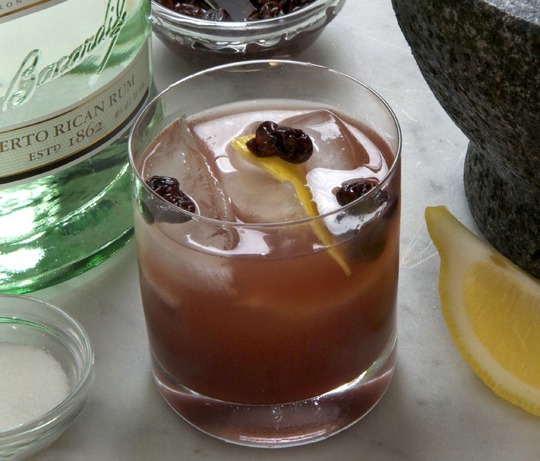
Sour Cherry Daiquiri. Photo by Donna Turner Ruhlman.
Some cocktails are spontaneous given what’s at hand. I happened to be making nougat, the French confection created by pouring cooked sugar and honey into whipped egg whites, then folding in nuts and dried fruits. The pix were so stunning in the Bouchon Bakery book, I simply had to give it a go and attempt a paired down version for the home cook. I considered adding rum-soaked dried cherries and so prepared these. But by the time the eggs whites and sugar had cooled to glossy perfection, I worried that the red-tinted rum, attracted by the sugar, would leach into the stunning whiteness of the nougat.
When the shooting was done for the day, I had a bowlful of rum soaked cherries. Hmmm. How to put to use? “Donna! Don’t put your camera away!” I shouted, post-work cocktail selfishly in mind.
I quickly grabbed my mortar and pestle and pulverized seven or eight soaked cherries and the rum (2.5 ounces in all) in the mortar, then strained it over ice (you don’t have to strain if you like your cocktails chunky), added equal parts lemon juice and simple syrup and had an uncommonly fine drink on my hands, a variation on my Traverse City Zinger.
The painful, truly painful, part of shooting these cocktails is that Donna takes forever to shoot! I watch, salivating like a Pavlov dog.
(A word about the mortar and pestle, which I sell at OpenSky. Seriously, if our house were robbed by a desperate cook, and they took this, I would be seriously bummed, I would swear at them most heinously. I grind toasted peppercorns and coriander to rub into beef—it’s the main spice mix for these killer pastrami short ribs—and pork and lamb. I make fabulous guacamole in it, and salsas. It’s big and heavy enough to make an aioli in, old-style, but not lava-rock-rough like a molcajete, which I find are too coarse for my needs. )
Without further delay, then, the Friday Cocktail:
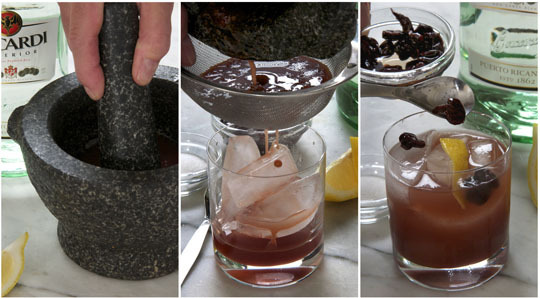
one, two, drink
Sour Cherry Daiquiri
2.5 ounces rum
5 to 10 tart dried cherries
1 ounce lemon juice
1 ounce simple syrup
Lemon peel
Soak cherries in rum for at least 5 minutes (and for up to 5 years). Pulverize cherries thoroughly in a mortar and pestle.
Strain into a glass; add ice, lemon, and syrup.
Garnish with a twist and more cherries if you wish.
If you liked this post, take a look at these links:
A few of my other rum based cocktails: Key Lime Daiquiri, Between the Sheets, and the Dark and Stormy.
Watch how Richland Rum is made outside of Atlanta, Georgia.
An interesting website that covers the history of rum.
Looking for something sweet? Try making a boozy rum cake.
© 2013 Michael Ruhlman. Photo © 2013 Donna Turner Ruhlman. All rights reserved.
April 18, 2013
Final Word on Battle of the Spoons(with Crème Anglaise)
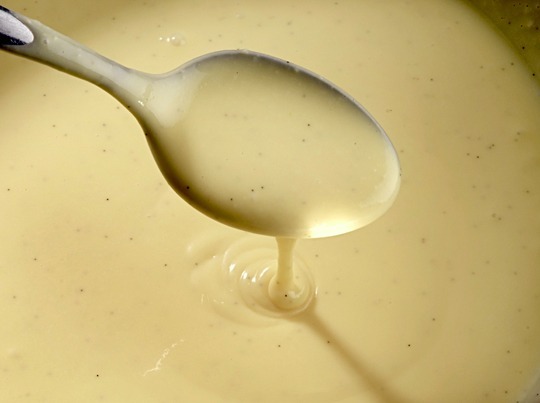
A perfect crème anglaise. Photo by Donna Turner Ruhlman.
The television personality and cookbook author Ted Allen stirred up a shit storm this week by calling me out on my hatred of the round wooden spoon, which he apparently has the hots for. He happened to mention our exchange at a City Harvest event to Eric Ripert, executive chef of Le Bernardin, one of the finest restaurants in the country, with whom I’ve worked closely, who added a little more caca to the pot by tweeting “Crème anglaise? Since the days of Escoffier, stir with a wood spoon, Ruhlman.”
He then phoned me to further faire caca into my cell phone until he conceded that it was the wood, not a round wood spoon, then was evasive, said a client had just arrived. But he handed the phone to his British-born, French-trained pastry chef, Laurie Moran, veteran of Per Se and Daniel in NYC and hired to fill the rather large shoes of chef Michael Laiskonis. Chef Moran’s response: everyone should use a rubber spatula. I did not disagree. He added that one needs a flat edge to fully sweep the bottom of the pot to lift the cooking egg yolk.
(Ted Allen, meanwhile, was tweeting that if I cooked my Anglaise properly, I shouldn’t need to worry about the bottom of the pan and therefore his round wooden spoon still wins.)
I asked Moran about a whisk. He said, as deferential as only Brits can be, that while one would certainly whisk the sugar and yolks thoroughly, you would never whisk the pot when all the ingredients were combined as he sensed—sensed meaning a cook’s intuition based on a lifetime of cooking—that a whisk would alter the texture of the sauce, something Eric also noted. He did stress the importance of the effectiveness of the spatula at sweeping clean the bottom of the pot as the custard sauce cooked (at which point I steek out my tongue at the venerable Monsieur Allen).
I hold firm that while even I feel a ’70s-ish nostalgia for the round wooden spoons that filled my childhood suburban kitchen, the round wooden spoon is an emblem of thoughtlessness of the American cook, an icon of kitchen ignorance and, in that ignorance, downright depravity, and therefore must take a militant stance on the stupid round wooden spoon, ask for a round wooden spoon intervention by Mr. Allen’s family and close friends, and suggest a burning of them in Cleveland’s public square.
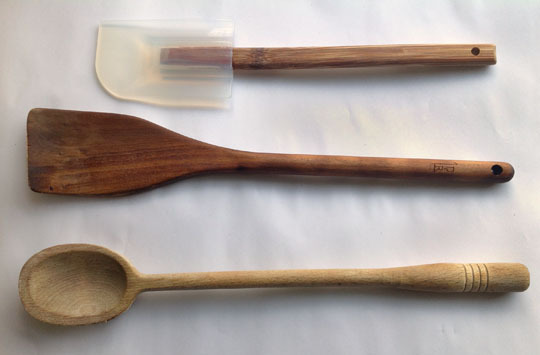
From top: heatproof rubber spatula, flat-edged wood spoon, American emblem of ignorance.
But then—and I say this with a heavy heart, something not mentioned either in my my Stupid Kitchen Tools video nor Mr. Allen’s—a world in which someone has spent money to invent, manufacture, and advertise the Rollie Eggmaster, arguably the stupidest cooking tool ever invented, hilariously demoed by Stephen Colbert on Tuesday, well, it makes one feel fairly certain that human beings are not long for this world. The Rollie Eggmaster is the beginning of the end of our species.
Until then, make a proper crème Anglaise. Here are Chef Moran’s proportions, halved, to make 500 grams rather than a kilo.
Crème Anglaise
294 grams milk
73.5 grams cream
1 vanilla bean, halved lengthwise
59 grams egg yolk
73.5 grams sugar
Bring the milk, cream, and vanilla bean to a simmer in a saucepan, then remove the pan from the heat and let the bean steep for 10 minutes or longer.
Meanwhile, set a bowl in ice and put a strainer in the bowl.
Remove the bean, scrape out the seeds, and return them to the pot. Put the empty bean pod in your sugar bowl.
In a bowl, whisk together the yolks and sugar thoroughly.
Bring the milk and cream back to a simmer. Pour about half of it into the yolks, whisking continuously, then pour it all back into the pan with the remaining milk and cook over medium heat, stirring continuously with a rubber spatula (or flat-edged wood spoon) until the sauce thickens to nappe consistency (when you lift the spatula out, you can draw a finger through the sauce).
Pour it through the strainer into the bowl set in ice, and stir with the spatula until the sauce has cooled.
Yield: 500 grams crème anglaise, a little more than 2 cups
If you liked this post, take a look at these links:
My post on making your own salted caramel sauce.
If you are British, nothing goes better then crème anglaise and a steamed pudding.
Modernist Cuisine has a few interesting takes on desserts for the home chef.
Whip up a batch of banana fritters and dunk them in the crème anglaise.
© 2013 Michael Ruhlman. Photo © 2013 Donna Turner Ruhlman. All rights reserved.
April 15, 2013
Food Art Video
The above is, technically, an intro to the Chicago restaurant Alinea, led by restaurateur Nick Kokonas and chef Grant Achatz, whose story I recount in The Reach of a Chef. The question “Are chefs artists?” almost always annoys me. Grant told me he considers himself as such (and not without reason). His mentor Thomas Keller considers himself, the chef, a craftsman. In a long-ago post I reprint from Reach of a Chef my chapter on chef Masa Takayama, making a case I almost argue against: that the chef can, in certain instances, rise to the level of artist. That chefs are artists is a facile assumption that is almost always wrong.
To complicate matters in the funnest of possible ways, in walks Christian Seel, a chef as actual filmmaker, creating this, one of the most dramatic series of food, cooking, dining images I’ve encountered. If the Food Network/Cooking Channel/Bravo/Travel Channel ever gets its collective act together and discovers the balls to broadcast this kind of work, I’ll be there. Kokonas noted that Alinea patron, friend, and consultant Gary Adcock of Studio 37 was a consultant on the above film. Seel, a CIA grad who has cooked in some of the world’s best restaurants, is currently the media director for the Next/Aviary/Alinea group. I’ve asked him to discuss the film and his thinking:
By Christian Seel
I just read a great book by the Academy Award–winning film editor (In the Blink of an Eye). In it, he prioritizes the six most important elements of film editing. At the top of the list is emotional content. With any short, the first thing I personally do is try to identify an emotion and a story that I want to convey, and work from there. It sounds very obvious put like that, but its not always so, given that you start with something abstract and no characters or dialogue.
Music and sound are always critical with any production. As I’m behind the camera, it’s often difficult to simultaneously capture great images and record quality audio—fundamental aspects of a dining room or kitchen. With the Alinea Intro here, I was lucky enough to find a song that had the exact characteristics I was looking for—an experience larger than life, grandiose. When you have the right music, it does a lot to carry the emotional content. A short really starts to come together and have a life of its own. When you edit with the music, it kind of tells you what it wants to be. A good song or music will have kind of a “drive” to it. It carries or drives you along, which in turn carries the video. Good music/songs will also have emotion and obviously rhythm that you can play off.
I was lucky enough to be able to use a RED Epic camera recently. It records at 5K resolution—roughly five times the resolution of HD video. It’s a serious Hollywood camera used to shoot The Hobbit, Oz The Great and Powerful, The Great Gatsby, and dozens of other major productions. You can play footage from that camera on an IMAX screen and it would still look sharp. It’s really cool how far technology has come. From a practical standpoint, I can stabilize and crop footage and still maintain a very high playback resolution.
With this short in particular, I wanted to convey first a sense of excitement and anxiety that comes from sitting down at a highly anticipated restaurant meal. With Alinea specifically, there are so many hundreds of thousands of movements that go into the production of a meal. If you observe, you can see how all these movements have to fall into place in a very precise way, almost like a choreographed show or a symphony. It’s really impressive and amazing in my opinion. When I cut the piece together, I tried to convey that. The cuts in the video are based almost entirely on these individual movements—as if the employees themselves are moving to this internal rhythm. Each action in the restaurant is like a note being played on an instrument. I don’t pretend to take credit for this concept. I wanted to show bold and decisive movement, which is extremely agile and precise at the same time. With Alinea, the food is so carefully conceived and executed that I try to light it and shoot it as simply, honestly, and straightforward as possible, in hopes of doing it justice.
You can respond to Christian on Twitter: @XtianSeel
If you liked this post, check out these other links:
My Had Something to Say Video on Stupid Kitchen Tools.
Todd and Diane of White on Rice Couple are the ones who made my Had Something to Say series.
Emilia’s favorite Alinea movie made by Christian: 21st Century Ltd.
Chef Brian Polcyn’s video on trussing a chicken.
© 2013 Michael Ruhlman. Photo © 2013 Donna Turner Ruhlman. All rights reserved.
April 12, 2013
Friday Cocktail Hour: The Lemon Drop
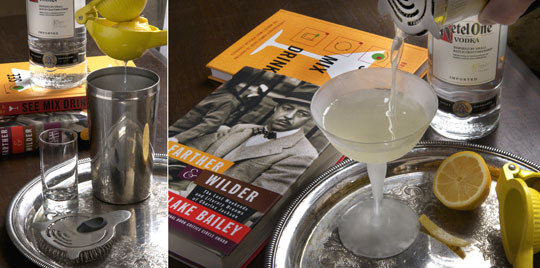
Lemon Drop. Photo by Donna Turner Ruhlman.
A couple weeks ago, inspired by my BFF Blake Bailey’s latest bio, Farther and Wilder (boffo WSJ review here), I offered a Tom Collins, gin-lemon-soda. But on retrospect it was only OK—it would be the perfect libation on a hot summer evening, but it was March. Also, I could hardly taste the gin, and what’s the point of that unless you’re drinking the cheap shit? Just to check, I ordered one last weekend at a restaurant and it was so bad I didn’t even finish it (which is not like me, that’s how bad it was—how do you screw up something as simple as that?).
But I loved the idea of the heavy lemon. I loved the idea of, every now and then, not being aware of the alcohol in my drink. What does this lead to? Well the latter leads to using vodka, America’s go-to, boneless-skinless-chicken-breast default spirit. Yes, sometimes I have this, even want it (Moscow Mule!—need to invest in the sporty mugs next time).
So last weekend whilst looking for a cocktail using vodka that was worth making, I went to my sterling cocktail companion See Mix Drink, and found the Lemon Drop. I had been making lemon curds for the new book and had an abundance of lemons. Thus it was decided. And it is absolutely lovely. I will be making this very drink tonight before watching the finale of Season 5 of Madmen so that I am properly primed for Season 6. It’s alcoholic lemonade, a delightful cocktail.
Lemon Drop
2 ounces vodka
1 ounce lemon juice
1 ounce simple syrup (one part sugar dissolved in one part water)
Lemon peel
Combine all fluids in a shaker, fill with ice, stir or swirl for a minute or two, and strain into a coupe glass.
Garnish with lemon peel.
If you liked this post, take a look at these links:
My other vodka cocktail post, besides the MM, is the Bloody Mary.
A fascinating article on Harry’s New York Bar in Paris from the NYT—learn about its great history.
The Vodka Museum in St. Petersburg, Russia.
Learn how to make your own infused spirits.
© 2013 Michael Ruhlman. Photo © 2013 Donna Turner Ruhlman. All rights reserved.
April 11, 2013
Farm Transparency v. Farm Secrecy

A foie gras farmer feeding her ducks during the brief period of gavage. The ducks at the bottom of the photo showed no signs of illness or discomfort (they were quite merry, actually, if that’s possible). Photo by Michael Ruhlman.
Last summer, on assignment for Condé Nast Traveler, I visited a farm that raises ducks for foie gras, driven there along harrowing roads in southwestern France by Kate Hill. I’d never seen the practice, vilified in America, of force-feeding ducks and, being in the land of foie gras and confit de canard, I had to see for myself. The farm, Souleilles, run by Yves and Geneviève Boissière, is wide, wide open in the town of Frespech. The husband and wife were warm and welcoming and watched me take an iMovie and iPhone pix of the practice while Yves spoke at length about the process. The ducks are pasture raised most of their lives, then force fed for 14 days, beginning with a little less than half a pound twice a day, increasing to less than a pound (400 grams) at the end. Granted, it’s a lot of food for that size animal, but I saw them in the final days of their mortal coil, and they waddled happily between the old lady’s legs, pointed their beaks skyward of their own accord as the woman popped the tube in and massaged the food down toward their gizzard, a process that took about five seconds. They then waddled away briskly, quacking and flapping, to the other side of the cage. They weren’t crowded, showed no evidence of sickness, had plenty of room, and lived in clean pens, behaving not at all like puking frat boys stumbling all over each other but rather more like Beatrix Potter’s Jemima Puddle-Duck. Again most of their lives are spent in a pasture the size of a football field. A better life than the millions of Perdue chickens enjoy surely.
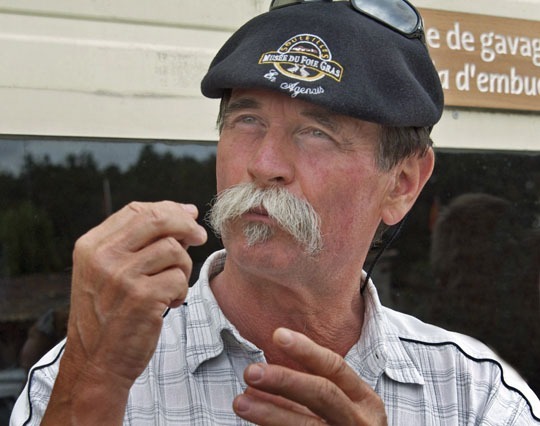
Yves Boissiere, who raises ducks in Frespech, in southwestern France.
Photos by Donna Turner Ruhlman.
All this came to mind because of the news of the current bills lobbied for by Big Ag to make it illegal to try to record harmful farming practices in the United States. Which is hardly the exception in our factory-farming, cheap-meat country. If it were the exception, why would Big Ag be spending big money trying to prevent the harm from being broadcast?
Jedediah Purdy wrote an articulate op-ed two days ago in the NYTimes and the paper’s editorial board seconded it. America doesn’t need more farm secrecy, it needs more farm transparency. If you don’t want someone to be allowed to film inside your building where the food our kids are eating is being slaughtered, you should be shut down until you welcome the videographer.
If you want to eat meat, I believe you should be present—or, better, a participant—in the death of at least one of the animals that you eat. I took part in a chicken slaughter last summer. It was not easy, nor should it be. I cooked the chicken I killed and gutted. I took very good care to cook it perfectly. I witnessed a humane slaughter of a Mangalitsa hog the following fall and a demonstration of how it was debristled, gutted, and broken down. I’ve twice visited a slaughterhouse in Ashland, Ohio, where locally raised cows are dispatched and broken down for their muscle and bone, a federal inspector checking each one (they’re big animals and it’s pretty gruesome). I’ve written about why I believe it is ethical and yes, humane, to eat meat. I think vegetarianism is a healthy and good choice if that’s what you want and what your body wants. I believe that veganism is lunacy, and arguably inhumane (but a superb weight loss plan and, adhered to long enough, perhaps even an effective birth control strategy).
But regardless what I believe, we are a meat-eating country and the Perdues, McDonalds, Smithfields, Monsantos, and Cargills are going to keep it that way, have no fear. What we and, more importantly, our legislators can do is refuse to sell out to the Big Ag lobbies for their election cash and help to make animal husbandry as humane as possible nationwide and without exception. It’s very, very hard given the billions of animals we slaughter yearly for food. But surely the first step is transparency, not secrecy, which these new bills are trying to ensure so that you can have your tasty McRib and boneless Kentucky Fried for pennies. It’s good for big business and helps your senator and representative keep that glinting smile for the camera. But it’s certainly not good for the animals we rely on for our food, which means it’s not good for your family.

“These ducks are bound for the cassoulet pot tomorrow,” says Yves, “but don’t tell them, they’ll go on strike.”
These are happy, healthy ducks in clean uncrowded conditions. The 400,000 ducks raised for foie gras in this country enjoy the same. I wish this were true of the billions of other animals we kill for food (hello, California?!).
We, worms’ meat ourselves, in Mercutio’s memorable phrase, should do better. Though now that I think about it, perhaps Congress should outlaw worms?
If you liked this post, there’s something wrong with you; this post should piss you off no matter whose side you’re on. Keep reading:
My recent rant Cook Your Own Food.
Civil Eats is a great resource to learn more about food policy and politics.
Support local farmers by finding the ones near you at Local Harvest.
Take a look at Michael Pollan’s books and site.
© 2013 Michael Ruhlman. Photo © 2013 Donna Turner Ruhlman. All rights reserved.
April 8, 2013
Auntie Reggie’s Minestrone

Regina Turner Simmons and her weekday minestrone/photo by sister Donna.
Tuesdays or Wednesdays are usually soup days as it was last week when Donna’s sister, Regina, was here for Cakes 101, not only to teach me cake basics and the creams and curds that fill a cake and give a cake flavor. I also wanted to be able to show what a proper cake could look like in the book we’re currently working on, and as Regina bakes wedding and special-occasion cakes in the Hudson Valley, we brought her in for a working visit.
We spend Thanksgiving with Donna’s family in Germantown, NY, and last year she had two big pots of soup on the stove as family converged on the house, one of which was so beloved by my daughter I asked Regina to make while she was here. She asked only if I had some chicken stock and I said, I’d made some from the chicken we’d had the night of her arrival. She said, “Oh, the soup will be really good then.”
Soup really is markedly better with your own chicken or vegetable stock, but here, there are so many ingredients water will do or, if you must, good quality store-bought “broth” (though I’d diluted it with water).
During a break in the action, Regina got the mise en place together (cut onions, herbs, tomatoes, etc). It all fit on a small cutting board and was prepared long before the soup was ready (you could do it all a day ahead and refrigerate it if you need to get dinner on the table fast). The soup itself comes together in about 2o minutes. That and a salad and some good toasted bread made a hearty weekday dinner (and nourishing with all vegetables, and garbanzo beans). Thanks, Regina!
Auntie Reggie’s Minestrone
4 cans 15-ounce cans garbanzo beans (or a pound of dried, cooked separately, my preference but we didn’t have time)
1 onion, small dice
6 garlic cloves, minced
1 tablespoon olive oil
salt to taste (a couple of teaspoons)
2 teaspoons cumin
1 quart chicken stock or water
1 small can tomato paste
1 tablespoon minced rosemary
black Pepper to taste
soy sauce to taste (about a tablespoon)
6 plum tomatoes, small dice
2 cups cooked little pasta
2 tablespoons minced parsley
parmigiano-reggiano (optional)
Puree half the garbanzo beans.
In a large heavy pot, saute the onions and garlic in the olive oil over medium heat, adding the salt as you do.
When the vegetables are soft, about five minutes, add the liquid, tomato paste rosemary, pepper, soy sauce, pureed garbanzo beans and tomatos and simmer for about ten minutes.
Add the parsley and pasta and continue to cook till the pasta is hot.
Serve, topped with the parsley and grated reggiano.
This will feed 6 to 8 and is great left over.
If you liked this post, check out these other links:
My recent posts on making French Onion Soup and Matzo Ball Soup.
How to make your own consommé and clarifying it.
Food and Wine shares some recipes for Spring soups.
I of course used the Dalton-Ruhlman offset serving spoon and set the table with the offset soup spoons!
© 2013 Michael Ruhlman. Photo © 2013 Donna Turner Ruhlman. All rights reserved.
April 5, 2013
Friday Cocktail Hour: The Hasty Negroni
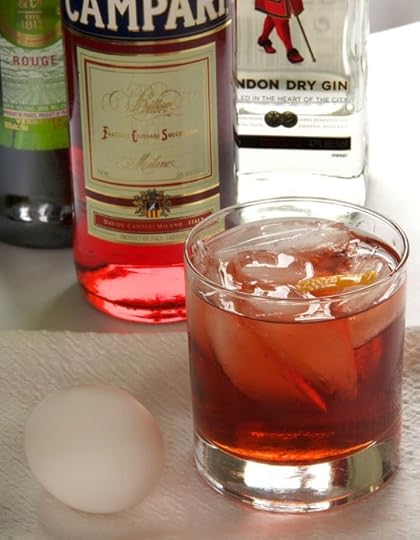
The Hasty Negroni. Photo by Donna Turner Ruhlman.
There was no other way given everyone’s schedule. We arrived from a relaxing vacay with Mom in West Palm on Monday night, and Donna’s sister, Regina, a professional cake whisperer, arrived first thing the next day ready to work (and teach).
I am cake challenged. I’m sweets challenged. My idea of sweets is pictured above. But the subject I’m writing about now, cleverly integrated into the above photo, demands that I address cakes. Thus, despite Regina’s patience, energy, and expertise, each day has for me ended with a feeling of depletion and fatigue, requiring a single end-of-the-day cocktail before I began dinner (which would be followed by more baking—cakes can be, should be, frozen—and/or photography).
So I wanted something strong, complex, familiar, and easy at the end of these challenging days, no straining into a chilled goddam glass, and no egg whites for crying out loud. I have a perfect 2-ounce shot glass; I filled it with gin, then filled it with equal parts Campari and sweet vermouth, a version of a great but not perfect cocktail, the Negroni. This version is stronger, but the ice mellows it out. And it’s not overly sweet-bitter, which the traditional Negroni can be. It’s also a great example of how proportions of classics can be varied in keeping with a situation. And if you don’t have or want to spring for the Campari, then just add six or seven shakes of bitters.
This week, it’s a hasty Negroni, in honor of my beloved cake-expert sister-in-law.
The Hasty Negroni
2 ounces well gin (or expensive gin if you’re taking pix)
1 ounce Campari (or tons of bitters)
1 ounce sweet vermouth
ice
orange twist (optional)
Put all the fluids in a large lowball glass. Fill with ice. Garnish with an orange twist if you have the energy.
Try to forget your day.
If you liked this post on the Regina Negroni, check out these other links:
My recent cocktail post on the Boulevardier, Tom Collins, and the classic Manhattan.
Saveur covers the history of Campari and what makes it bitter.
A recipe for a Campari orange passion cocktail.
The Museum of the American Cocktail blog.
© 2013 Michael Ruhlman. Photo © 2013 Donna Turner Ruhlman. All rights reserved.
April 3, 2013
Ham: Butcher & Larder Style

Rob Levitt, owner and head butcher of Chicago’s The Butcher & Larder.
Photos by Huge Galdones.
Say you have a whole ham and your wife, named Donna, doesn’t want the thing hanging in your closet for a year, drying out for prosciutto. Or you live in a fifth-floor walk-up in Manhattan and don’t have a wife named Donna but you also don’t have a closet, let alone a drying room. Or you have a whole ham but do not have a holiday dinner to prepare and fourteen people to feed.
Such is usually the case, in fact, so what do you do with a whole ham? I get this question all the time. The answer is that you break it down into smaller, delectable parts. Here’s what one butcher, Rob Levitt, of Chicago’s The Butcher & Larder, does with his ham. It’s difficult of course to put into words exactly where to draw a knife blade through a large cut. The only way truly to learn is by doing it.
You’re going to make mistakes, put a gash in an otherwise gorgeous top loin, for instance. That’s OK! You can still eat it! Next time you’ll know—that’s how you learn. Just remember that the ham is a heavily worked part of the body so many, though not all, of its muscles can be tough, and therefore must be tenderized mechanically (that is by slicing thinly across the grain or by pounding) or with moist heat (this is, by cooking it low and slow). But it also contains some of the tastiest meat on the pig and has abundant skin (rich in the protein collagen, which will melt into gelatin). Brian Polcyn and I write a lot about what to do with whole hams in our books Charcuterie and Salumi, transforming them with salt and time. Here’s how Rob Levitt (@butcherlarder) transforms the big ham with that invaluable kitchen tool we call a really sharp knife. (Photography by the excellent Huge Galdones.)

A fresh ham.
How to Turn a Big Fresh Ham into Delicious Smaller Cuts
by Rob Levitt
For those of you who love the idea of “nose-to-tail“ eating but find offal … off-putting … I have good news. While I’m thrilled there are so many chefs and butchers buying whole animals and focusing on total utilization, and no longer too conservative to put a tongue, foot, or kidney on their menus, this kind of cooking still eludes many ambitious home cooks. While lamb, venison, and other larger beasts offer all kinds of uses, the nose-to-tail champion is the pig. And the biggest single cut of the pig, the fresh ham, has so much more to offer cooks than cooking or dry-curing it whole.
Ask a pig farmer which parts of the pig he has the most trouble selling and he’ll say, likely without hesitation, the ham. These days with the overwhelming popularity of testa, headcheese, and anything on a menu containing “pig face,” or cheeks, I would have a harder time procuring pigs heads than hams.
If you say “ham” to a farmer or butcher, they immediately think raw pork, but if you say ham to just about anyone else it means anything from prosciutto to honey-glazed and spiral-cut. To clarify, a fresh ham is the back leg of a pig and can be put to use in countless different ways.
It can, in fact, be cooked whole as a roast. Often brined first, it does fabulously in place of a suckling pig on a spit or in a smoker as a large roasting joint for a party. But the parts that make up the whole are what I’m interested in.
We are all familiar with a smoked ham hock. Deliciously sticky and smoky, it is the best thing for your split pea soup or red beans and rice, but as a fresh, unsmoked cut of meat it also has a lot to offer. It is a fantastic braising cut with a surprising amount of unctuous, lip-smacking meat and can be dropped into the crock pot before work to be ready for dinner when you get home. At Cochon in New Orleans I had a fresh hock that had been braised, coated with mustardy bread crumbs. and finished in their wood oven. Fantastic. To remove the hock, cut through the skin and meat about 4 inches down from the top of the hock. Cut all the way around the hock and saw through the bone. (Here’s an inexpensive saw if you want one—they’re called meat saws, why, I have no idea; they cut through bone, not meat. Please use a knife for the meat, not a saw. If you don’t want a saw in the kitchen, a butcher will cut the shank for you, or specify that you’d like the hock off when you order the pig or the ham—M.R.)
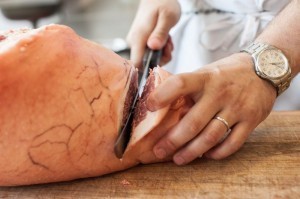
Removing the hock.
Perhaps you are looking for something to throw on the grill, but are tired of the usual chops and feel tenderloin is a bore. Try a pork sirloin steak. Removing the sirloin is a bit tricky. Find the aitch bone—part of the pelvis that remains on the ham cut—and cut along the top of it and straight down.

Removing the aitch bone.
Look for the aitch, or hip, bone (it is easy to spot at the base of the ham) and cut along the bone with the tip of your knife. It will curve up toward the top of the aitch and you should be able to connect the two cuts. Pull back on the aitch bone toward you and find the ball and socket joint. Slide the tip of your knife between the ball and socket and sever the tendon holding the two together. At this point you should be able to follow along the shape of the bone and remove it cleanly. Remember to keep your knife against the bone and take your time. To remove the sirloin, cut straight across just below the ball joint. (While I’m doing my best to describe this in words, the only real way to learn is to do it yourself. Use your common sense, find your own way—always avoiding waste if you make a mistake—and don’t be hard on yourself.)
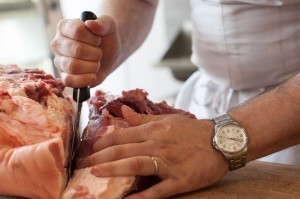
Removing the whole sirloin at the top end of the ham.
Trim any tough looking bits of meat (there is usually an easily removable flap with lots of connective tissue just below where the ball joint was) and trim into a roughly rectangular roast and score (or remove) the skin. Sliced into steaks, the sirloin has tons of flavor and is a great value. Cooked over indirect heat on a grill, the fat picks up great smokiness and the skin gets crispy.
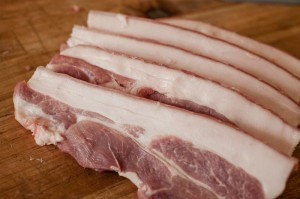
Sirloin steaks with fat and skin.
The sirloin also makes for a delicious boneless roast. Complete with cracklin’ skin, it is a fun and economical alternative to a loin roast.
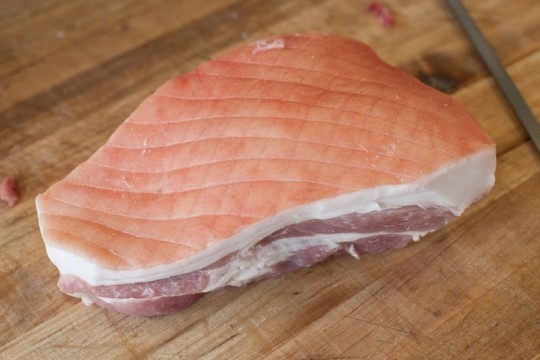
Whole sirloin roast with skin scored.
The top round of pork—the big inside muscle when the ham is on its side, skin-side down—is the perfect cut for a simple, lean, and tender roast. It can be cut into chunks for kabobs, sliced thin and marinated for tacos or fajitas, or cooked like a pot roast and shaved for a unique and delicious “French Dip” sandwich. To remove the top round, face the ham with the ball joint at four o’clock. With the tip of your knife, cut just behind the ball and against the femur bone to find the natural seam.

Rob is finding the natural seam to remove the top round.
Once you see the silver skin, follow it up toward the hock, making sure to keep your knife against the bone. As the top round frees from the ham, pull it away from the bone as you cut.

Following the natural seam of the top round.
Cutting downward, you will find a large, somewhat obvious seam of fat and tissue. Cut along this seam and the top round will peel off easily.
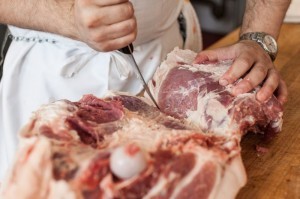
Peeling off and removing the top round.
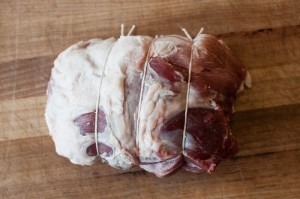
Tied top round roast.
Once the top round is removed, cut along the femur and remove it along with the remaining hock meat. Separate the joint and save the femur for stock (or pork marrow on toast—delicious!) and the hock for mini pulled pork or a simple braise.

Rob removes the femur from the ham.
As a cook, I have very little love for pork tenderloin. Though tender, I find it bland and boring. For my taste and for anyone’s budget the pork eye round is a great, lean grilling cut. The eye round is the long, thin muscle on the side of the ham visible after you cut off the top round. It is easy to find the seam at the hock end. Once located, follow it with your fingers down to the base of the ham, freeing up the muscle as much as possible. Use the tip of your knife to free it from the rest of the ham and trim away any fat and connective tissue. Similar in shape to the tenderloin and very lean, it soaks up a brine or marinade exceptionally well. It may not be meltingly tender like a tenderloin, but its extra bit of chew is made up for by the porky wallop it hits you with. The eye round is great sliced thin—slicing it thinly is a form of tenderizing—for stir-fry and is a versatile cut for the grill, broiler, or skillet and best left with a blush of pink in the center. This will be my go-to cut this summer for the grill.
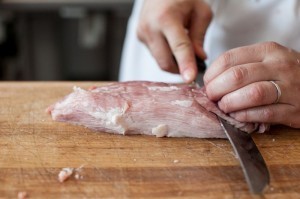
Pork eye of the round being sliced for stir-fry, kabobs, grilling. Cutting it thinly helps to tenderize it.
Another great alternative to the pork loin is the bottom round. The meat has a shorter grain so it isn’t quite as tender, but this same quality gives the cut an uncanny ability to soak up a brine. Set the whole piece (around 3 pounds) in a tub of beer, salt (a 10% brine is perfect for short times), and spices; an hour or two later you have a juicy, lean, and incredibly flavorful pork roast perfect for a crowd. The bottom round does great cut into chunks and skewered, sliced thin for cutlets or a bit thicker as an alternative to boneless chops.
It is easily separated from the sirloin tip by following along the natural seam.

Rob cuts through the natural seam between the bottom round and the sirloin tip.
You will have a long, somewhat rectangular piece of meat with a nice layer of fat on one side. Fat side down, find the heavy silver skin on either side of the muscle and remove it.
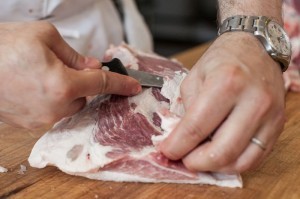
Trimming the bottom round roast.
Trim any other bits of connective tissue and trim the muscle into a uniform rectangular roast. I usually score the fat … because it’s pretty.
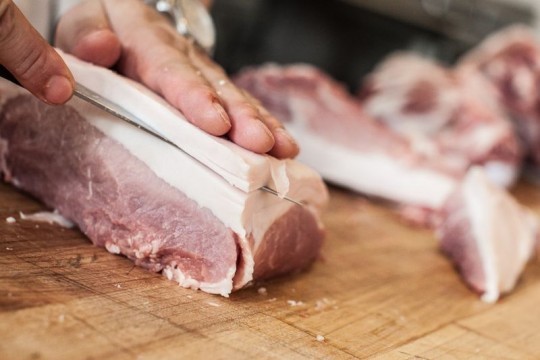
Trimming a bit of the fat from the bottom round. Save the fat to grind with other trim for sausage.
What remains is great for cutting into chunks for skewering, or grinding into sausage and pâté.

Pork bottom round roast, skin scored.
To be clear, these cuts wont change your life. You are not going to grill a pork eye round and never want a chop again, but that doesn’t mean it isn’t a delicious, easy to cook cut of meat. One of my biggest challenges as a whole animal butcher is providing plenty of cuts suitable for all methods of cooking in all price ranges. Just because you can’t afford a pork loin roast it shouldn’t mean you are limited to sausages, ground pork, or stew meat. And while I love offal and its recent rise in popularity, it isn’t the only way to cook and eat with a sustainable, nose-to-tail mentality. The fresh ham is a bit uncharted, but as sustainability becomes more and more important we should recognize that there are a lot of great options between the nose and that curly, little tail.
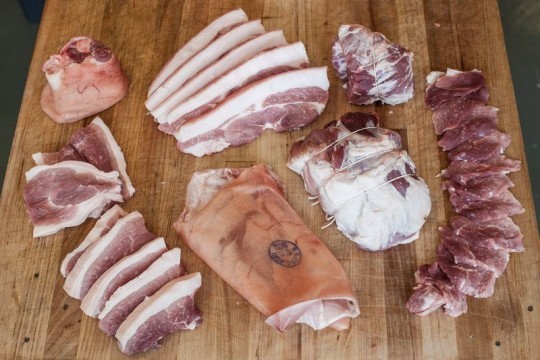
Fresh ham cuts. The skin, mainly protein on fat, adds great body and flavor to soup, stews, and stocks.
If you liked this post, you might be interested in these links:
My posts on making bacon, corned beef, or Canadian bacon.
Other local butcher shops: Lindy & Grundy, the Meat Hook, and the Spotted Trotter.
Heritage Foods and Local Harvest can help you find local meats.
© 2013 Michael Ruhlman. Photo © 2013 Donna Turner Ruhlman. All rights reserved.
Michael Ruhlman's Blog
- Michael Ruhlman's profile
- 354 followers



